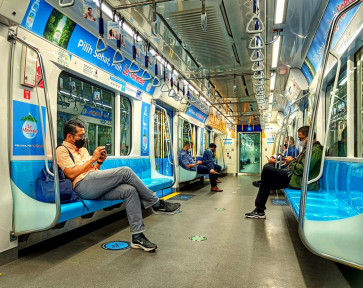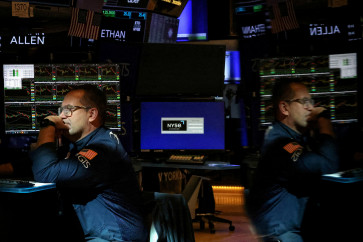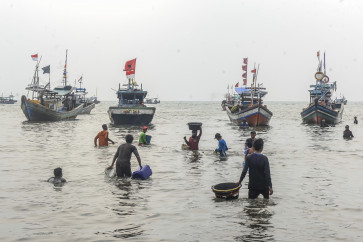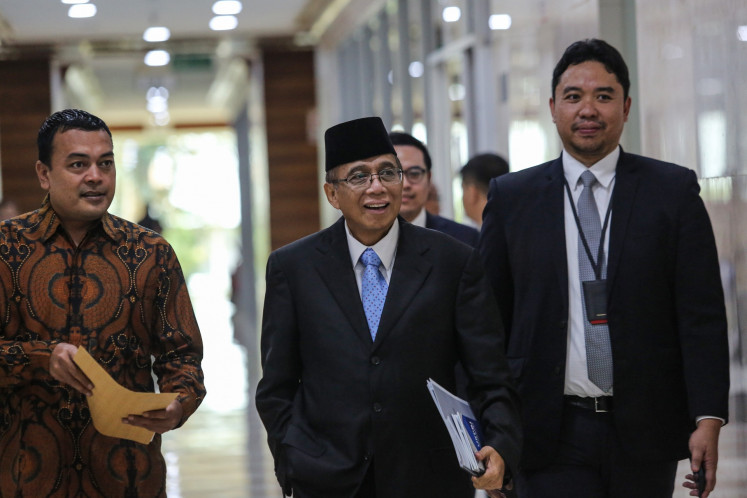Popular Reads
Top Results
Can't find what you're looking for?
View all search resultsPopular Reads
Top Results
Can't find what you're looking for?
View all search resultsMexican prints: From posters to art
Mexican graphic art dominates the exhibition "Bridge of Spaces" at Ark Gallery here
Change text size
Gift Premium Articles
to Anyone
Mexican graphic art dominates the exhibition "Bridge of Spaces" at Ark Gallery here. Opened on Wednesday, Feb. 25, it introduces an important part of Mexican art that has remained virtually unknown so far.
Indeed, Mexican artists were mostly known by Diego Rivera, the celebrated artist of large colorful murals and Frida Kahlo, an equally prominent Mexican artist whose life and times have given rise to such dramatic films and literature, not in the least because of their tempestuous relationship.
But little was it realized that Diego Rivera also made graphic art, as revealed by a lithograph dated 1932 depicting Emiliano Zapata, hero of the Mexican Revolution.
Diego Rivera (1886-1957) is just one of the many Mexican artists who have produced and are producing graphic art of the most premier quality.
Other mural artists such as Jos* Clemente Orozco (1883-1949) and David Alfaro Siqueiros (1896-1974) also took to printmaking at a time when they and other artists, during the Mexican Revolution (1910-1920) to overthrow the 30-year dictatorship of Porfirio Diaz, sought to pursue social change through the use of direct visual art.
Graphic art by its particular feature that allows large multiplication of one image became the preeminent tool to disseminate awareness-raising political and social messages that would reach as many people as possible.
Thus the Mexican Revolution had become a major stimulus for Mexican graphic art to become popular in the Mexican context of Art.
Jose Guadalupe Posada (1852-1913), a printmaker and social critic during the Mexican Revolution is largely credited as the pioneer.
The "Taller de Gr*fica Popular" (TGP, Popular Graphic Arts Workshop) was an important collective of established and emerging artists who had committed themselves to the use of direct visual art in the service of social change. Their medium of choice was monochrome relief prints - linoleum prints and woodcuts.
What makes the current exhibition of note is that it shows that the art of posters made for propaganda purposes using realistic images, have evolved to become a recognized part of Art in its variety of mediums and expressions.
Regrettably, no details or information could be obtained on the specific type of print: everything was just called "engraving", whereas some of the artists are known for their specialty in lithographs and etchings which differ from engravings by a working method using acid to achieve features such as intricate crevices and lines.
Nevertheless, the fineness of skill and depth of thought, and often somber moods shining through, are engaging features that unfailingly draw the viewer into a world of great beauty.
This is particularly true for the abstract colored work Figuras Humanas by Luis Lopez or Jardin de Vienna by Dutch born Jan Hendrix who settled in Mexico since the 1970s and has been preoccupied with natural forms.
Or, Flor Minor's dramatic Urbano featuring a man's upper body and upward looking face, with the reflections of buildings on his shirt and in the background.
There is also the semi-surreal Lilith by Lucia Maya, said to be a disciple of Frida Kahlo, and known for using the lithographic grease pencil. And there is also the work by Paloma Torres showing bold lines and Leoncito Villanueva's fine print titled Mujer Jaguar.
As the Mexican artists are mostly mature artists who have had a long experience with graphic art, the Indonesian artists presented here are not only young in terms of age, but also in their experience of making graphic art their way of individual expression.
Maryanto, Popok Tri Wahyudi and Surya Wirawan come from a background of cartoonish poster-making efforts to stimulate democracy in the country.
Surya Wirawan used graphic art in relation to his social activism, as part of Taring Padi, an artists' collective that used to create posters and murals, publish a newsletter and participate in street performances with puppets, poetry and musical groups.
Popok Tri Wahyudi's name is closely linked to the defunct Apotik Komik, a group of artists engaged in political and social commentary using the graphic media of comics, murals and posters.
Meanwhile, Maryanto has recently been involved with etching. While presenting them in combination with the Mexican "heavyweights" may appear somewhat unbalanced on the part of the curator, their works in intaglio (Maryanto), etching and aquatint (Surya Wirawan) and color etching (Popok Tri Wahyudi) signals a hopeful future.










